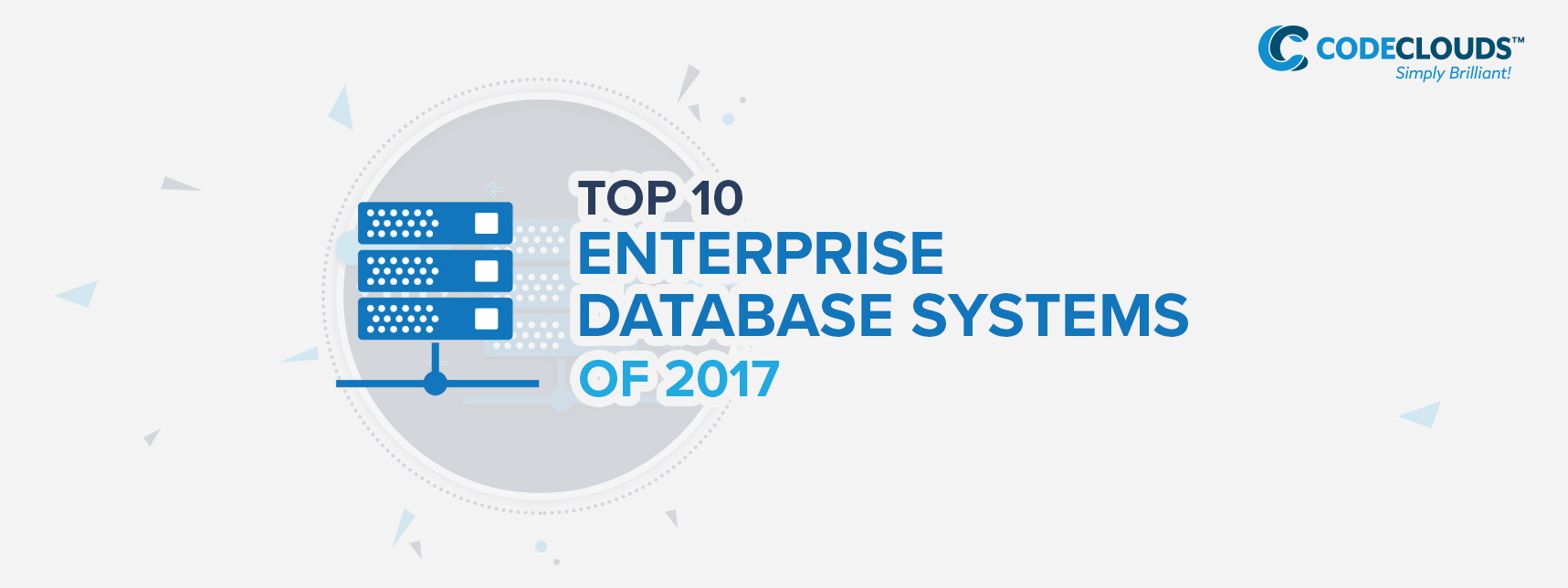Overview
It can be hard to choose the right database layer for you, especially if you need to process data on an enterprise scale. There’s a lot of options, and they all have their own strengths and weaknesses. Now that the debate around SQL vs. NoSQL has calmed down a bit, let’s take a look at the top 10 enterprise database systems.
It's been an interesting few years for databases. Tech generally moves lightning fast, but the DB world had remained relatively static for decades until NoSQL started gaining popularity in the early 2010s. For a while it looked like they would knock SQL off its perch, but now that the dust has settled, we have a clearer view of where all these systems sit in our ecosystem. There are more options than ever before, and it can be hard to choose. Let’s break it down and see what the top 10 database systems are in 2017.

1. Oracle
You knew this was coming. Oracle have remained the stalwart at the top of the database business for over 40 years and don’t seem likely to be beaten any time soon. They run both SQL and NoSQL databases, small—scale and enterprise databases, cloud databases and physical databases for your office. There’s nothing Oracle doesn’t do, and there’s nothing they don’t do well. Governments, banks and major global institutions run on Oracle DBs because they have traditionally provided the best of the best.
Their more powerful databases are prohibitively expensive. They have specialized hardware and operating systems, and their pricing model is a complicated process of multiplying core counts by a pricing factor based on where the architecture lies in the pricing models, often tens of thousands of dollars annually.
This also means subjecting yourself to Oracle audits to ensure you are paying proper licensing for features and the hardware/VMs you are using it on. Even some features that are activated by default lead to separate licensing charges. Oracle has been the subject of a lot of criticism for their business model, and without careful planning and the right consultants, you can find your business facing an exorbitant amount of charges in an audit.
In general, Oracle is better suited for larger enterprise applications and going with them has many advantages, but it can be a messy process.
2. MySQL
A critical component in the classic LAMP stack, MySQL remains one of the more robust RDBMSs out there. Around 2015-2017, a lot of evangelists were saying it would go the way of the dinosaurs, but MySQL has defied expectations and continues to be a huge part of web and application development. After all this time, it’s still the second-most popular database in the world and that shows no signs of changing. Despite its acquisition by Oracle, it remains totally open—source and that means totally free. Current used by: Facebook, Twitter, bedroom developers everywhere.
3. MongoDB
The reigning king of NoSQL, Mongo’s stock price has risen and risen over the last few years. It’s the engine running Amazon’s global tech empire, and is unbeatable when it comes to high volumes of unstructured data. It’s a core component of the popular MEAN stack, which runs almost entirely on JavaScript-based technologies. This makes it relatively easy to code and debug, since your developers only need to master a single language. If you’re planning to go big, you can’t do better than Mongo; it was designed from the ground-up to handle massive transaction volume, and nobody does it better. We’ve talked about the difference between SQL and NoSQL databases before on this blog, so be sure to check it out.
4. Microsoft SQL Server
A bit of a dinosaur at this point, though it still powers a lot of legacy apps. It remains very well-integrated with other Microsoft products and services, and this makes it an excellent choice for businesses who make extensive use of Microsoft. It’s one of the easiest databases to set up and run, and that makes it great if you have a lot of plates spinning—it’s a lot less likely that something will go wrong because there’s a lot less than can go wrong. To slightly misquote the old office wisdom, nobody ever got fired for buying MSSQL. It’s still the third most-popular database in the world and those usage numbers say something: a lot of the time it’s older systems that it would be costly to replace but it also means the DB is doing its job. It’s a lot cheaper than Oracle, but still on the pricey side: $15,000 per core.
5. Redish
Redis is absolutely lightning-quick. It’s not easy to learn and it doesn’t scale very well, but if you want raw speed and power, you absolutely cannot do better. It’s NoSQL (key-value) and it can be harder to find an engineer to run it but those that do run it have notably high satisfaction rates. If MySQL is a cheap, reliable sedan and Mongo is a four-wheel drive, Redis is a drag racer. In an age where load times are critical, you can’t ignore the value of a database that can send data at you that quickly and cleanly.
5.5. Hadoop
Not technically a database, but a critical part of the enterprise database system; Hadoop is an ecosystem of its own that helps to control and manage NoSQL systems. If you’re dealing with large data volumes and have a NoSQL database picked out, Hadoop should be your second stop. Another Apache foundation release (or rather, a set of releases), Hadoop is totally open-source.
6. PostgreSQL
PostgreSQL is an object-relational database that can handle a much broader set of data types. It’s often found in online gaming applications, domain registries and data center automation suites. It’s open-source, but manages to stand very respectably against its corporate competition. Major enterprises like Skype run on Postgre, and it has an extremely dedicated community. There are PostgreSQL evangelicals out there who will tell you it’s the absolute best of the best. I’m not sure I’d go that far, but it’s the most versatile and if that’s what you’re looking for, then it’s a great fit.
7. MariaDB Enterprise
MariaDB is a fork of MySQL created after Oracle acquired Sun Microsystems in 2010. Creator Michael Widenius was worried that Oracle would lock down the MySQL code so he created an open-source alternative. It runs almost identically to MySQL and this is an intentional design decision: it’s made so developers can switch easily from one to the other. MySQL never became closed-source and the systems haven’t diverged much, so this is mostly a matter of taste: if you don’t like Oracle for whatever reason, there’s a version of MySQL that doesn’t have their fingerprints on it. 10.3.14 includes improved protection against network-level attacks and faster delivery of high-performance applications. Google and Facebook both run on MariaDB—Google transitioned from MySQL in 2014.
8. Cassandra
Apache are better known for their servers, but their Cassandra noSQL database management system is one of the best around. Facebook uses Cassandra for their messaging app, and it’s the go-to database layer for major sites like Yahoo and Pinterest.
9. IBM DB2
IBM’s direct challenger to Oracle boasts of significant cost savings when migrating to their system-up to 39 percent within a three-year period. Their latest release is IBM DB2 Linux, Unix, and Windows 11.1. This is the only kind of database that is fully optimized specifically for IBM Power Systems like POWER8. Gone are the days when the IBM mainframe was the must-have purchase for any office, but they’re still a major player and their systems are worth it. Nobody ever got fired for buying—
No wait, I already used that one. Well, you get the point.
10. Teradata
The creator of the first terabyte-level database, Teradaya is the father of enterprise data warehousing. Touted as a VLDB, or Very Large Database System, it is an incredible at handling Big Data analytics, IoT, BI services, and other emerging enterprise trends. A lot of databases started small and then iterated up to enterprise work, but Teradata (like Mongo) was built 100% to handle high volume.
And there you have it: ten of this year’s best enterprise database systems to choose from. There really is no one ‘best’ system for everyone, as needs from one industry or company to another will vary. Particularly now that NoSQL has opened up the market, there’s a lot more variety. That said, the ten options listed are all solid: there are hundreds of options out there, and you’ll do yourself a favour if you limit it to these ten.

If you’re looking for a developer with MySQL, MongoDB, MariaDB, and Redis experience, we have dedicated developers available at an affordable monthly rate. Contact us to learn more about our database management and consulting services.
Share this article
1.6k reads
Similar Reads








